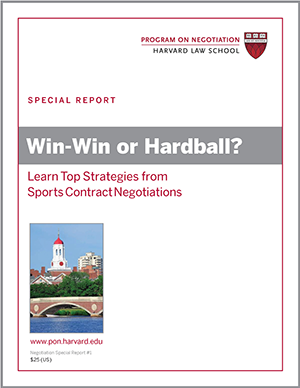
When financial, political, and legal conditions change suddenly, fortunes are both made and lost. How can you make sure you take advantage of unexpected opportunities and avoid being the odd man out during business negotiations?
The battle for Wachovia Corporation in the fall of 2008 occurred in the midst of a credit crisis and government bailout of the U.S. banking system. Not only was the economy changing drastically day by day, but as we will see, laws were being rewritten as well.
In the face of these bewildering circumstances, the fight for Wachovia offers a case study in negotiating on the fly. Here, drawing from accounts in the Wall Street Journal, Harvard Law School and Harvard Business School professor Guhan Subramanian’s book on corporate dealmaking, Dealmaking: The New Strategy of Negotiauctions, we describe how events unfolded daily during this tumultuous time and then review the lessons learned.
Weekend of Worry in Business Negotiations
It was Friday, September 26, 2008 and Wachovia Chairman and CEO Bob Steel faced a cold, hard fact: if he didn’t find a buyer by Monday, his bank would have to file for bankruptcy protection.
Burdened by credit card and loan defaults, Charlotte, N.C.–based Wachovia had seen its stock plummet. Without a sale, Wachovia almost certainly would join Lehman Brothers and Washington Mutual in the trash heap of once-storied financial institutions felled by the credit crisis.
Working furiously through the weekend, Steel and his team made inroads with San Francisco–based Wells Fargo, a mega-bank that had emerged from the subprime mortgage mess virtually unscathed. Wells Fargo reportedly was prepared to offer more than $20 billion for Wachovia. Even better, Wells Fargo wasn’t asking for the government assistance that rival Citigroup was insisting on for a sale.
But Wells Fargo chairman Dick Kovacevich abruptly walked away from a deal late that Sunday night. Stunned and terrified, the Wachovia team “fell to the floor,” according to one Wall Street Journal source.
A Sleepless Night in Business Negotiations
But within hours, a knight in shining armor rode in to save Wachovia. Federal Deposit Insurance Corporation (FDIC) chairwoman Sheila Bair persuaded Citigroup chairman and CEO Vikram Pandit to come up with a last-minute deal. With senior government officials acting as brokers, the two banks negotiated through the night. They emerged at 6:30 a.m. Monday with a rough two-page “letter of intent”—notably not an official merger agreement—for Citigroup’s purchase of Wachovia.
For Wachovia, the deal was unattractive but better than bankruptcy. Citigroup would get only the parts of the bank that it wanted for $1 per share, along with a guarantee that the FDIC would back any future losses on Wachovia’s loans above $42 billion. In addition, Wachovia got a line of credit to sustain it through the weeklong wait for the acquisition to close.
To protect itself during this week, Citigroup insisted on an exclusivity clause that barred Wachovia from negotiating with other potential buyers.
Another New Deal
That week, Citigroup scrambled to line up investors to help support its purchase, and the “new partnership” was trumpeted in a full-page ad in USA Today. On Thursday, October 2, 2008, Wachovia CEO Steel spent the day at Citigroup headquarters in New York City talking HR issues with the new owners. In the meantime, lawyers on both sides hammered out a definitive agreement to be signed the next day.
But around 7:30 p.m. on Thursday, Wachovia got a surprise call from federal regulators: Wells Fargo, which had passed on making an offer just four days before, was putting together a merger proposal. It was back in the game.
Two hours later, Wachovia’s Steel was thrilled to receive Wells Fargo’s formal offer, which was much more attractive than Citigroup’s. Wells Fargo was willing to buy all of Wachovia for $7 per share and without asking for a cushion against future losses from the FDIC. Late Thursday night, Wachovia’s board of directors accepted the offer, and Steel called Citigroup CEO Pandit with shocking news: “We cut a new deal.”
Related Win-Win Negotiations Article: Negotiating in the Heat of the Moment
Originally published in 2012.






” Citigroup insisted on an exclusivity clause that barred Wachovia from negotiating with other potential buyers. ” Did they actually get it ?